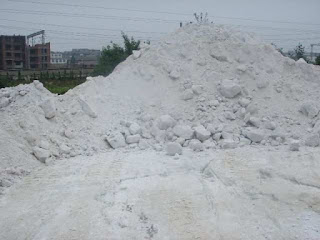Separation by Leaching
When mechanical
methods of separation cannot secure optimal metal value of an ore,leaching is
an alternative, either as a complement or as an overall process.
Most of the
leaching process is feed preparation by crushing, grinding and in some cases pre-concentration
and roasting.
The separation
is normally done by creating retention time for the chemicals to penetrate the
feed.
The waste and
heap leaching operations are typically low in investment but high in cost of
chemicals. Recovery is normally low (below 60%).
The agitation
methods (con current or counter current) are high in investment but are paid
back in higher recovery.
Leaching by size
In leaching
there is always an optimum in the relation feed size versus recovery.
This balance
between cost for size reduction and value recovery is important to establish
for high value ores, see below.
Leachants
Leaching of Metals
Below find the flow sheets for classical leaching circuits, heap
leaching for coarse fractions (crushing only) of low grade ores and agitation
leaching for finer fraction of high value ores.
In the Heap leaching process the ground is protected by a sealed
surface, collecting the leaching chemicals, re- circulated by pumping. When the
solution is “pregnant” its clarified by sedimentation or sand filtration and
taken to metal recovery by electrowinning.
In the Agitation leaching circuit the feed is finer (typical –200 microns) and the slurry moves in the same
direction as the chemicals (con current flow). In this case, the pregnant
solution has to be recovered from the solids by mechanical dewatering due to
particle size,
Gold Leaching
Enrichment by
leaching is mainly used for recovery of gold often in combination with pre
separation by gravity. If free coarse gold is released during size reduction, this
fraction (typical – 1mm) is recovered in gravity spirals. If finer fractions of
free gold are present centrifuge technology can be applied (not covered here).
Alternatively, when processing an ore containing gold metal only, leaching with
carbon adsorption are frequently used.
Carbon Adsorption
Leaching reaction
Process stages
1. Leaching by
agitation to dissolve Au by reaction above. Agitators are arranged in con
current flow. CIL (Carbon
in leach) is a method where the
gold adsorption by carbon is done in the leaching circuit. The method, seldom
used due to high operating costs, is not covered here.
2. CIP (Carbon in pulp) adsorption by slow agitation using active carbon granules to adsorb
the Au solution from the pulp. Agitators are arranged in counter current flow
(carbon travelling towards the pulp flow). Carbon granules must be:
a. Hard to resist
abrasion (made from coconut shells)
b. Coarse to be separated
from slurry by sizing (1-3 mm, 16-6 Mesh)
c. High in specific
surface
3. Carbon recovery is
done by sizing over a screen (cut at 0,7 mm, 24 Mesh) bringing the loaded
carbon out of the pulp system
4. Au stripping is
the process of removing the gold solution by “washing” the carbon granules in a
solution (cyanide + Na OH) at 135°C. (retention time 6-8 hours).
5. Carbon reactivation is
needed after the washing to restore the active surface of the granules. This is
done in a kiln at 125° C
6. Cyanide destruction of
the pulp leaving the CIP circuit is done in an agitator adding an oxidant
(typical hypocloride) bringing remaining cyanide to a harmless state.
7. Au electrowinning by
plating out the gold metal is done with steel wool cathodes. These cathodes are
sent to fluxing and smelting.
sinonine can also provide sand washing plant EPC.






评论
发表评论